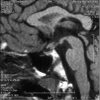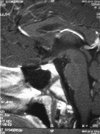Permanent central diabetes insipidus with complete regression of pituitary stalk enlargement after 4 years of follow-up
- PMID: 21318063
- PMCID: PMC3005636
- DOI: 10.4008/jcrpe.v1i1.4
Permanent central diabetes insipidus with complete regression of pituitary stalk enlargement after 4 years of follow-up
Abstract
A 14 year-old patient was admitted because of a history of polyuria and polydipsia. A diagnosis of central diabetes insipidus (CDI) accompanied by growth hormone (GH) and gonadotropin deficiency was made. Hypophyseal magnetic resonance imaging (MRI) of the patient demonstrated isolated pituitary stalk enlargement. Although GH deficiency and gonadotropin deficiency were transient, CDI was persistent despite the regression of the pituitary stalk enlargement over the 4 years of follow-up.
Keywords: Pituitary stalk thickness; central diabetes insipidus; multiple anterior pituitary hormone deficiency.
Figures
Similar articles
-
Central diabetes insipidus in children and young adults.N Engl J Med. 2000 Oct 5;343(14):998-1007. doi: 10.1056/NEJM200010053431403. N Engl J Med. 2000. PMID: 11018166
-
Clinical presentation and outcome of children with central diabetes insipidus associated with a self-limited or transient pituitary stalk thickening, diagnosed as infundibuloneurohypophysitis.Clin Endocrinol (Oxf). 2017 Aug;87(2):171-176. doi: 10.1111/cen.13362. Epub 2017 Jun 5. Clin Endocrinol (Oxf). 2017. PMID: 28444954
-
Thickened pituitary stalk with central diabetes insipidus: report of three cases.J Formos Med Assoc. 2001 Mar;100(3):198-204. J Formos Med Assoc. 2001. PMID: 11393116
-
Erdheim-Chester disease and pituitary involvement: a unique case and the literature.Endocr J. 2014;61(2):185-94. doi: 10.1507/endocrj.ej13-0419. Epub 2013 Dec 3. Endocr J. 2014. PMID: 24304810 Review.
-
Magnetic resonance imaging and symptoms in patients with neurosarcoidosis and central diabetes insipidus.Endokrynol Pol. 2019;70(5):430-437. doi: 10.5603/EP.a2019.0035. Endokrynol Pol. 2019. PMID: 31681969 Review.
Cited by
-
Necrotizing infundibuloneurohypophysitis: case report and literature review.Endocr Pathol. 2012 Sep;23(3):205-11. doi: 10.1007/s12022-012-9214-y. Endocr Pathol. 2012. PMID: 22661312 Review. No abstract available.
-
Endocrine Disorder in Patients With Craniopharyngioma.Front Neurol. 2021 Dec 2;12:737743. doi: 10.3389/fneur.2021.737743. eCollection 2021. Front Neurol. 2021. PMID: 34925209 Free PMC article. Review.
References
-
- Wang LC, Cohen ME, Duffner PK. Etiologies of central diabetes insipidus in children. Pediatr Neurol. 1994;11:272–7. - PubMed
-
- Maghnie M. Diabetes insipidus. Horm Res. 2003;59:42–54. - PubMed
-
- Ghirardello S, Melattia C, Scagnelli P, Maghnie M. Current perspective on pathogenesis of central diabetes insipidus. J Pediatr Endocrinol Metab. 2005;18:631–645. - PubMed
-
- Alter CA, Bilaniuk LT. Utility of magnetic resonance imaging in the evaluation of child with central diabetes insipidus. J Pediatr Endocrinol Metab. 2002;15:681–687. - PubMed
-
- Lipscombe L, Asa SL, Ezzet S. Management of lesions of the pituitary stalk and hypothalamus. Endocrinologist. 2003;13:38–51.
Publication types
MeSH terms
LinkOut - more resources
Full Text Sources



